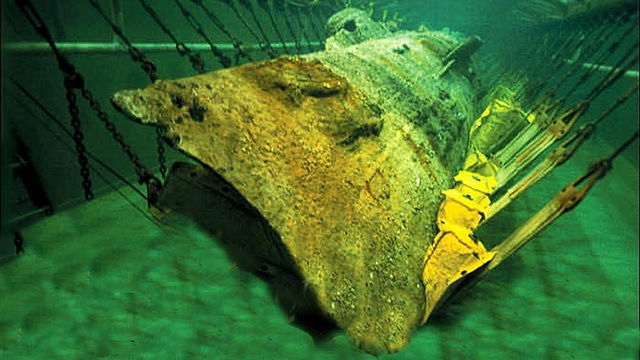In 1864, three years after the onset of the American Civil War, an ingenious new form of seafaring combat vessel ventured into the dark waters of Charleston Harbor and into the annals of history. Now researchers and historians are finally ready to begin piecing together what happened to the HL Hunley that fateful February night — but first, the Confederate attack sub will need a good long soak in the tub.
The Hunley proved to be a mixed blessing for the Confederacy. On one hand, the 12m long, 6.8-tonne hand-cranked semi-submersible was the first such submarine to sink a Union frigate (the USS Housatonic), proving the effectiveness of the design. On the other hand, the eight man vessel killed 21 crew members in three (three) separate sinkings during her brief service.
The Hunley‘s first success was also her final attack. Just after she sank the Housatonic, she mysteriously sank off the coast of Charleston NC and remained lost until 1995. Five years after being rediscovered not far from a busy shipping lane, the Hunley was raised from the seafloor in a widely-publicized 2005 effort by the Friends of the Hunley conservation group.
As the conservation team explains on its website:
Preventing the disruption of an artifact’s equilibrium is the primary purpose of archaeological conservation. Any artifact retrieved from a marine environment should be placed back in water as soon as possible before it starts to dry out or react with oxygen in the air. For this reason, the H.L. Hunley submarine was raised from the seabed and immediately transported to the Warren Lasch Conservation Center. The vessel was kept wet through the use of a water sprinklers during its eight-hour transit to the lab. Once at the laboratory facilities, the submarine was placed in a custom-built, 55′ x 18′ x 9′ (16.8 x 5.5 x 2.75 m) metal conservation tank and filled with fresh water.
The water was refrigerated to 50°F (10°C) over a 3-day period in order to retard the growth of fungus and algae as well as to cut down the rate of corrosion. The water chemistry in the tank is monitored continuously for pH, temperature, chlorides, conductivity, and oxygen.
In addition, the hull of the submarine is being subjected to an impressed current system designed by Corrosion Control Incorporated, which inhibits further corrosion, until the interior has been fully excavated. Following the excavation, the use of other corrosion inhibitors will be employed in the conservation process in order to stabilise the vessel.
Over the last nine years, conservationists and historians have carefully excavated the interior of the submarine, clearing away a century’s worth of sediment and recovering the bodies of those who died on board. It wasn’t until last year that researchers were able to see that the charge canister that sank the Houstonic was attached to just a 5m spar. This handle would have been far too short to sufficiently protect the Hunley’s crew from the resulting shockwave, and suggests that they may have been rendered unconscious by the blast, unable to crank the propeller which also pumped in air. However, a closer look at the hull will be required to confirm if this really was the case. And that’s where the 288,000 litres of sodium hydroxide comes in.
See, the sea salt and sand and grit and marine life that have infested the Hunley’s hull over the last 100 years can’t simply be scraped off, for fear of damaging the antique structure underneath. So instead, conservationists plan to fill the vessel’s 288,000-litre conservation tank with the mildly corrosive hydroxide mixture and let the vessel soak for three months. This should be enough to sufficiently loosen the sediment.
“Chiseling away the concretion will allow us to travel back in time, potentially helping us learn what happened to the Hunley and her crew that night,” Lt Gov Glenn McConnell, the chairman of the South Carolina Hunley Commission, said in a statement.
Once the sub has had its soak, another nine months of scrubbing and scraping will be necessary to fully eliminate the encrustment and another four years of conservation to pull the salts out of the hull so that it can eventually be put on display in a new museum in North Charleston. [Stars and Stripes – Hunley.org]
